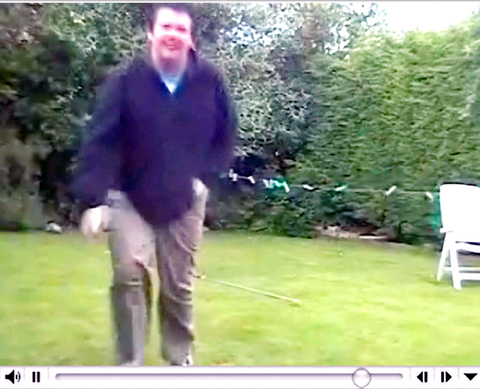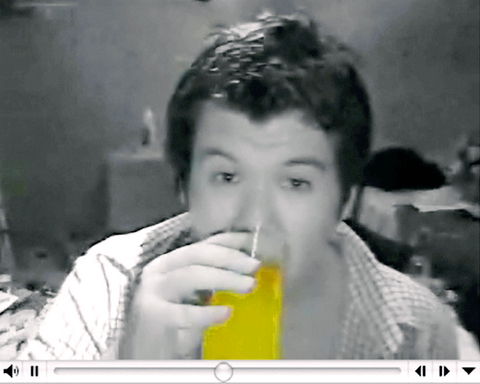Can you vlog a dead horse? Only if you make a video of it and post it on the Web.
After blogging came photo blogging and then, suddenly last year, video blogging. Video bloggers, also known as vloggers, are people who regularly post videos on the Internet, creating primitive shows for anyone who cares to watch. Some vlogs are cooking shows, some are minidocumentaries, some are mock news programs and some are almost art films.
Most simply are records of ordinary life. The Das Vlog recently demonstrated the virtues of urinating in the bathroom sink. Village Girl has posted a video of her two-year-old dancing with a friend. Josh Leo taped himself browsing through his old baby pictures and art projects. (The first book he wrote as a child, No, is excellent.) Fat Girl From Ohio is a man blogging largely about his wife's pregnancy.

As the video blog Reality Sandwich recently put it in a video of vegetable shopping, quoting a mantra of the vlogosphere: "Hey, mundane is the new punk."
At this point the video blogging world is still small enough that all vloggers appear to know one another and show up in one another's work. For instance, two vloggers, Amanda Congdon and Richard Hall, recently met and their encounter was vlogged and blogged on at least three different sites, from more than one perspective. Michael Verdi, who wrote the manifesto Vlog Anarchy, has two young daughters, Lauren and Dylan, both with video blogs. (Lauren shows off her Brownie badges; Dylan plays with Neopets.com and talks about a boy who can't get her name right.)
Already, though, it's beginning to look a lot like television, at least in spots. Some vlogs even share television's worries, chief among them the burden of coming up with fresh programming on a regular basis.

For instance, Rocketboom, an amusing and ambitious vlog posted by Congdon, looks like Weekend Update, the newscast on Saturday Night Live. Congdon has a wry look. She sits at a table in front of a map reading reports off sheets of paper. She tosses them after she's finished. She has correspondents in the field (who do things like give away the ending to the latest Harry Potter book), and she wears cute, nerdy glasses. She recently asked her audience to start sending her story ideas.
Another vlog, the Carol and Steve Show, in which a married couple offers up the tedium of their daily lives -- shopping, driving to the gym, arguing about American Idol -- has stolen its type and its theme music from the land of sitcoms. It wants to sell out, but who would buy? Maybe a laugh track would help.
One of the most winning vlogs is the 05 Project, the work of an 18-year-old in Keynes, England, Ian Mills, who has promised to post a video a day all year. He begins almost every short video by moving close to the camera and addressing the audience with a sweet formality: "Okay, so today ...."

In January, he showed the inside of his closet to prove he doesn't have just one set of clothes, but two. In February, he filmed a stuffed kangaroo seeking directions from a stuffed teddy bear sitting in front of a microwave oven. In March there was a video of a fire, with this note: "Damn im so glad i went to my grandparent's house today. If i hadn't, i wouldn't have seen this."
But now the 05 Project is beginning to look a lot like Fear Factor, minus the fearlessness. In June, when Mills found his well of ideas running dry, he asked his audience for challenges: an easy one, a moderate one and a hard one. In each "Challenge Ian" episode, he recites the three challenges, chooses one, and then makes a video of himself doing it.
One of his most charming features is that he always takes the easy challenge. "I'm not going to slam my fingers in the door," he said, in one episode. "This isn't Jackass," he said, referring to the television show.
So far, he has drunk a pint of raw eggs and vomited; jumped into a wading pool fully clothed; and spun around until he was dizzy. It doesn't sound like much, but Mills has a great sense of pacing and drama. He has Conan O'Brien's direct delivery and David Letterman's deadpan. In short, he has television charisma.
Right now it seems that video bloggers can't agree what vlogs are exactly, and some of them want to keep it that way. "What's the rush to define it now?" Verdi asks in his video manifesto. "It would be like trying to pick a career and a mate for a newborn."
But indeed, the newborn seems to have picked its mate. Congratulations. It's television!
WEB NOTES:
The Das Vlog: thedasvlog.blogspot.com
Village Girl: villagegirl.typepad.com
Josh Leo's videoblog: joshleo.blogspot.com
Fat Girl From Ohio: fatgirlfromohio.org
The Reality Sandwich: realitysandwich.typepad.com/blog
Rocketboom: rocketboom.com/vlog
The Carol and Steve Show: stevegarfield.blogs.com/videoblog
The 05 Project: noservicecharge.com/videoblog

The Nuremberg trials have inspired filmmakers before, from Stanley Kramer’s 1961 drama to the 2000 television miniseries with Alec Baldwin and Brian Cox. But for the latest take, Nuremberg, writer-director James Vanderbilt focuses on a lesser-known figure: The US Army psychiatrist Douglas Kelley, who after the war was assigned to supervise and evaluate captured Nazi leaders to ensure they were fit for trial (and also keep them alive). But his is a name that had been largely forgotten: He wasn’t even a character in the miniseries. Kelley, portrayed in the film by Rami Malek, was an ambitious sort who saw in

It’s always a pleasure to see something one has long advocated slowly become reality. The late August visit of a delegation to the Philippines led by Deputy Minister of Agriculture Huang Chao-ching (黃昭欽), Chair of Chinese International Economic Cooperation Association Joseph Lyu (呂桔誠) and US-Taiwan Business Council vice president, Lotta Danielsson, was yet another example of how the two nations are drawing closer together. The security threat from the People’s Republic of China (PRC), along with their complementary economies, is finally fostering growth in ties. Interestingly, officials from both sides often refer to a shared Austronesian heritage when arguing for

Among the Nazis who were prosecuted during the Nuremberg trials in 1945 and 1946 was Hitler’s second-in-command, Hermann Goring. Less widely known, though, is the involvement of the US psychiatrist Douglas Kelley, who spent more than 80 hours interviewing and assessing Goring and 21 other Nazi officials prior to the trials. As described in Jack El-Hai’s 2013 book The Nazi and the Psychiatrist, Kelley was charmed by Goring but also haunted by his own conclusion that the Nazis’ atrocities were not specific to that time and place or to those people: they could in fact happen anywhere. He was ultimately

Last week gave us the droll little comedy of People’s Republic of China’s (PRC) consul general in Osaka posting a threat on X in response to Japanese Prime Minister Sanae Takaichi saying to the Diet that a Chinese attack on Taiwan may be an “existential threat” to Japan. That would allow Japanese Self Defence Forces to respond militarily. The PRC representative then said that if a “filthy neck sticks itself in uninvited, we will cut it off without a moment’s hesitation. Are you prepared for that?” This was widely, and probably deliberately, construed as a threat to behead Takaichi, though it